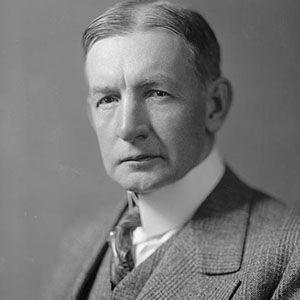Charles G. Dawes served as the 30th Vice President of the United States from 1925 to 1929. He was awarded the Nobel Peace Prize in 1925 for his plan to deal with German reparations following World War I.
Early Life
Charles Dawes was born in Marietta, Ohio in 1865. His father was a Civil War general. Dawes graduated from Marietta College in 1884. He went on to earn a law degree from the Cincinnati Law School two years later. In 1887, he moved to Lincoln, Nebraska, to pursue his legal practice. He ended up building a vast business empire. Ultimately, Dawes and his brothers owned 28 gas and electric plants in ten states. In addition to his utility holdings, Dawes was also successful in the banking industry, founding and serving as president of the Central Trust Company of Illinois.
Political Career
Dawes’ business success prompted the Republican party to seek his help in getting William McKinley elected President in 1896. After McKinley won, Dawes was rewarded by being appointed Comptroller of the Currency in the U.S. Treasury Department. In 1901, Dawes resigned from the Treasury to run for Congress. After losing his bid for a seat in the U.S. Senate, Dawes declared he was done with politics.
During World War I, Dawes served as chief of supply procurement for the U.S. forces in Europe. After the unification of the Allied command, General Dawes became the U.S. member of the Military Board of Allied Supply. In 1920, Dawes was appointed Director of the Budget, a position in which he completely overhauled the federal government’s budgetary procedures. The most significant reform was requiring every department to submit a budget and operate within it.
In 1923, President Harding appointed Dawes to head a commission to address Germany’s economic problems in the wake of World War. His plan, which became known as the “Dawes Plan” earned him the Nobel Peace Prize, which he shared with his British collaborator, Sir Austen Chamberlain.
Vice Presidency
Dawes was not the first choice for Vice-President at 1924 Republican National Convention. However, after Frank Lowden declined the nomination, Dawes was chosen as Calvin Coolidge’s running mate. President Coolidge, often referred to as “Silent Cal,” and Dawes were polar opposites. As a result, they never formed a close relationship while serving together in the White House.
Dawes started off on the wrong foot by upstaging the President’s inaugural address with his own speech after being sworn in as President of the Senate. Dawes was highly critical of the Senate rules, particularly the use of the filibuster. “Who would dare oppose changes in the rules necessary to insure that the business of the United States should always be conducted in the interests of the Nation and never be in danger of encountering a situation where one man or a minority of men might demand unreasonable concessions under threat of blocking the business of the Government?” he asked. Unless the rules were reformed, they would “lessen the effectiveness, prestige, and dignity of the United States Senate.”
Dawes’ vocal criticism spurred a national debate on the Senate rules. It also did not make him many friends in the Senate. At the end of his tenure as Vice-President, he stated, “I should hate to think that the Senate was as tired of me at the beginning of my service as I am of the Senate at the end.”
At the 1928 Republican National Convention, President Coolidge elected not to seek re-election. He also failed to support Dawes’ re-nomination, and Charles Curtis was selected to take his place. In 1929, President Herbert Hoover appointed Dawes to serve as the Ambassador to the United Kingdom. He later served as the head of the Reconstruction Finance Corporation, which coordinated the government response to the Great Depression. In 1932, he left that post to return to the banking industry. Dawes died in 1951.









